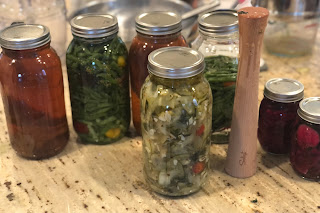Homemade Tomato Sauce!
The tomatoes and spices cooking down.
Recipe
1 cup good Extra Virgin Olive Oil
One yellow Onion
One head of garlic
1 bunch fresh basil
1 bunch fresh Oregano
1 sprig of fresh Rosemary
Kosher salt
Fresh ground pepper
Pepper flakes (optional)
- Sanitize jars
- Sprinkle the garlic with olive oil, salt and pepper, then wrap in aluminum foil and roast the garlic in the oven at 375 for 30-45 minutes
- Boil a large pot of water and put tomatoes in in batches until the skins burst
- Put the tomatoes in a bowl and let them cool
- Peel and clean the tomatoes- if you have a good food mill our a Vitamix, this peeling is optional
- If you have a food mill, break it out and put the tomatoes through it, if you don't have a food mill, squish the tomatoes with your hands. This is fun and very stress reducing!!!
- Dice the onion
- Heat the oil in a large dutch oven or stock pot
- Cook the onion until soft but not quite browned
- Put the tomato "juice" into the pot with the onion and add the garlic
- Chop and add the herbs, reserving one basil leaf per jar
- Cook on low for 1-2 hours until your desired consistency is achieved
- Salt and pepper to taste. Add pepper flakes if desired.
- Boil a large pot of water - creating a canning water bath
- Place either a tablespoon of lemon juice or 1/2 teaspoon of citric acid in each jar
- Place a basil leaf in each jar
- Ladle into jars and place the lids on
- Boil the jars according to canning standards (Boil 32 oz jars for 45 minutes).
- Remove the jars and make sure the caps have sealed by pressing them down and making sure they don't "click"

















































